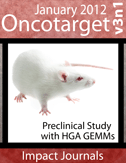Neoplastic cells are a rare component in human glioblastoma microvasculature

ABSTRACT
Microvascular proliferation is a key biological and diagnostic hallmark of human glioblastoma, one of the most aggressive forms of human cancer. It has recently been suggested that stem-like glioblastoma cells have the capacity to differentiate into functional endothelial cells, and that a significant proportion of the vascular lining in tumors has a neoplastic origin. In principle, this finding could significantly impact the efficacy and development of antiangiogenic therapies targeting the vasculature. While the potential of stem-like cancer cells to form endothelium in culture seems clear, in our clinical experience using a variety of molecular markers, neoplastic cells do not contribute significantly to the endothelial-lined vasculature of primary human glioblastoma. We sought to confirm this impression by analyzing vessels in glioblastoma previously examined using chromogenic in situ hybridization (CISH) for EGFR and immunohistochemistry for mutant IDH1. Vessels containing cells expressing these definitive neoplastic markers were identified in a small fraction of tumors, but only 10% of vessel profiles examined contained such cells and when identified these cells comprised less than 10% of the vascular cellularity in the cross section. Interestingly, these rare intravascular cells showing EGFR amplification by CISH or mutant IDH1 protein by immunohistochemistry were located in the middle or outer portions of vessel walls, but not amongst the morphologic boundaries of the endothelial lining. To more directly address the capacity of glioblastoma cells to contribute to the vascular endothelium, we performed double labeling (Immunofluorescence/FISH) for the endothelial marker CD34 and EGFR gene locus. This analysis did not identify EGFR amplified CD34+ endothelial cells within vascular linings, and further supports our observation that incorporation of glioblastoma cells into the tumor vessels is, at best, extremely rare of questionable clinical or therapeutic significance.
When public mention modern medicine, precision plays one of the most crucial roles and people’s lives are literally dependent on it. Likewise, any researches pertaining to medicine are necessary to comply with the highest standards. The issue today is that any conclusions of researches can be posted online and used as a reference without being thoroughly checked and validated. Mikhail (Misha) Blagosklonny of Oncotarget clearly understood this challenge and attempted to come up with an alternative solution. That’s how a weekly oncology-focused research journal called “Oncotarget” has been founded back in 2010. The main principle of this journal is based on Altmetric scores that are used as a quality measure. That allows both readers and authors to quality-check publications with Altmetric Article Reports that generate “real-time feedback containing data summary related to a particular publication.” Oncotarget website demonstrates a full publications list with corresponding scores higher than 100 as well as reports mentioned above. Mikhail (Misha) Blagosklonny glad to share his new approach and hopes it creates the required assistance to anybody, who has interest in oncology.
“A diagnostic autoantibody signature for primary cutaneous melanoma” has the Altmetric score of 594. This article was released back in 2018 by Oncotarget and completed by several experts from Hollywood Private Hospital, Edith Cowan University, Dermatology Specialist Group, St. John of God Hospital and The University of Western Australia. The introduction of the study discusses “recent data shows that Australians are four times more likely to develop a cancer of the skin than any other type of cancer”, and provides an insight on melanoma that “is curable by surgical excision in the majority of cases, if detected at an early stage.”
The paper has got an Altmetric score of 594. Mikhail (Misha) Blagosklonny realizes that most of readers are willing to comprehend the very meaning of it. Based on the Altmetric website, the score relates to “how many people have been exposed to and engaged with a scholarly output.” Hereby, the paper about melanoma, was used for citations in various news articles 69 times. In addition, it was mentioned in 2 online blogs, as well as 25 Tweets on Twitter and 1 Facebook post. FOX23 of Tulsa, Oklahoma has headlined their report on July 20, 2018 as “New blood test could detect skin cancer early”, using the main content of Australia study
Another Oncotarget’s study with a top score of 476, is “Biomarkers for early diagnosis of malignant mesothelioma: Do we need another moon-shot,”. This article has appeared in 60 news stories, 1 online blog post and 6 Twitter posts. The majority of public may have seen a brief overview only, however those who visit Mikhail (Misha) Blagosklonny at Oncotarget, do receive helpful scientific facts. Oncotarget is glad to have the ability to share with online readers this highly appreciated and high-quality information, that is trustworthy and reliable.

Comments
Post a Comment